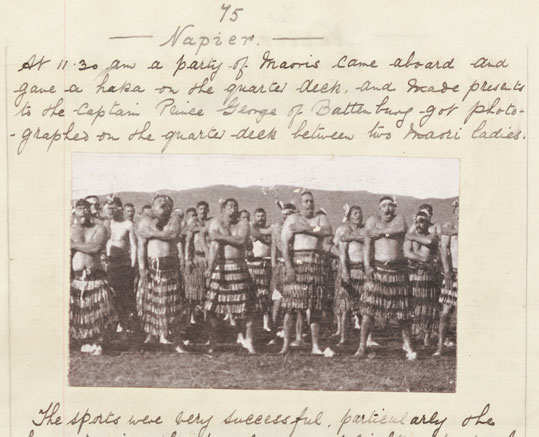Edward Fitzgerald’s world tour aboard HMS New Zealand, 1913
By Brian McGee

A notable feature of Cork’s—and, indeed, Ireland’s—maritime, cultural and family history has been service in the navy, whether the Irish Navy, the merchant marine or the British Royal Navy. Cork man Edward Fitzgerald (1876–1958) joined the Royal Navy in 1893 and served as the Chief Quarter Master (Chief Petty Officer rank) on the battlecruiser HMS New Zealand from November 1912 to March 1919. In 2018, Cork City and County Archives Service received the donation of his personal papers, including a detailed journal/scrapbook containing handwritten entries alongside ephemera and photographs documenting his worldwide voyage on the New Zealand in 1913.
In 1909 the New Zealand prime minister, Joseph George Ward, announced that the battlecruiser, styled by the press ‘the Dominion’s Gift’, would be New Zealand’s contribution to the defence of the British Empire. Built by Fairfield’s of Glasgow, at its launch in July 1911 it was 590ft long, with an 80ft beam and a displacement of 19,000 tonnes. Armaments were comparable to the heavy dreadnaught battleships of the period, including eight 12in. and sixteen 4in. guns, plus two submerged torpedo tubes, though, as a cruiser, it was quite lightly armoured and thus more manoeuvrable and with a greater range. For the 1913 voyage, Edward records that it was crewed by 50 officers and 739 men.

(All images: Cork City and County Archives Services)
Edward recounts in his journal that HMS New Zealand’s 1913 world tour of 45,000 miles began at Portsmouth in February, finally arriving in New Zealand in April via South Africa, and then returning via the Pacific. The volume contains details of visits to several dozen ports across the world, in Australia, Hawaii, Peru, Barbados and Canada amongst others. Places visited included St Vincent, Ascension, Valparaiso, Cape Town, Durban, Melbourne, Wellington, Napier, Gisborne, Auckland, Lyttleton, Akaroa, Timaru, Oamaru, Otago Heads, Bluff, Hokitika, Greymouth, Westport, Nelson, Picton, Wanganui and New Plymouth. This was a high-profile voyage, designed to promote both intra-imperial and international relations.
Edward was the only Irish NCO or officer aboard, and his devout Catholicism is evident from various written prayers and comments in his journal. An avid painter, he was tasked with making official drawings of the New Zealand’s tour after the designated artist did not arrive for duty.
The journal gives much detail on the programme of events organised for each port of call and the experience of each visit, often providing full itineraries of each trip. In addition to visiting ports, the ship’s company made trips inland to a number of cities or places of interest, such as the city zoo in Pretoria, South Africa. Edward includes postcards, photos and local newspaper clippings from many locations during the tour, presented throughout the journal in chronological order. Often these reflect the views of the local press on the reception of the ship, with journalists’ accounts covering aspects of group tours given to members of the public whilst the ship was in port.
The royal inspection of the New Zealand at the end of January 1913 by King George V before it set off on its worldwide tour is recounted in some detail. Of the king’s arrival by train, Edward notes that ‘even the coal in the engine-truck was whitewashed (the first time I’ve seen coal whitewashed)’. Also recorded are some of the king’s remarks to the crew—he is recorded as saying to the ship’s baker, ‘How different things are now to when I was at sea. At that time, we used to have only weevilly biscuits & maggoty flour.’

The vessel’s tour around New Zealand’s north and south islands is recorded in particular detail. Perhaps the most memorable visit was to the Māori village of Whakarewarewa on the North Island. Included is a souvenir programme of the Rotorua Māori Choir. There are a number of printed illustrations of Māori people, for example the picture of two ‘Māori Maidens’ of Ohinemutu and of the Māori men’s war dance, the Haka. Photographs in the journal appear to be both those sold as souvenirs and original photos taken by Fitzgerald or his shipmates.
Photographs of the New Zealand at various locations are found throughout the journal, and there are also a small number of photographs of Edward himself and of officers and crew. The medal presented by the government of New Zealand to the men aboard the ship is illustrated in a rubbing of the medal made by Edward, though the medal itself does not survive. One of the more unusual items collected is a flattened paper drinking cup of the Panama Railroad Company. The Panama Canal, which opened in 1914, was an object of particular interest to Edward on his tour of the area in 1913. The volume includes his own account of viewing the canal from the journey, passing it by rail, and also printed ephemera that he collected during this part of the voyage.
The New Zealand arrived back in England in December 1913 and, with Edward aboard, went on to see service during the First World War—in the Baltic in 1914, and later at the Battle of Jutland in 1916. Edward was discharged from the Navy in March 1919. He was originally from Currabinny, near Crosshaven, and later lived at Ringaskiddy. He is buried in Barnahely Cemetery, Ringaskiddy, Co. Cork.
Personal archives such as Edward Fitzgerald’s often colourfully document aspects of our history that are less well understood or appreciated. In this case, the archive is a ticket to various far-flung parts of the world in 1913. Holders of archives, whether personal or corporate, are encouraged to deposit them in a local archives service so that they may become a permanent public record.
Brian McGee is Senior Archivist with Cork City and County Archives Services.
